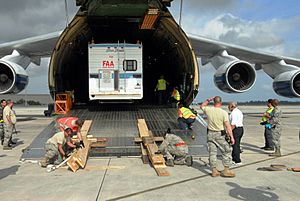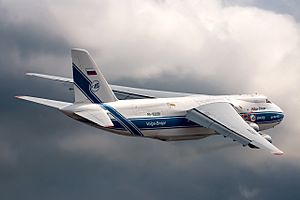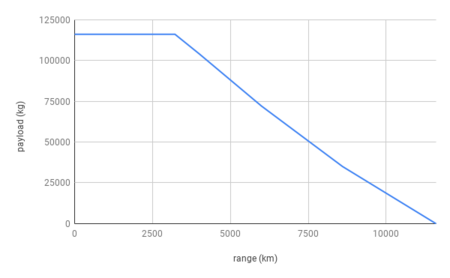Antonov An-124 Ruslan facts for kids
Quick facts for kids An-124 Ruslan |
|
|---|---|
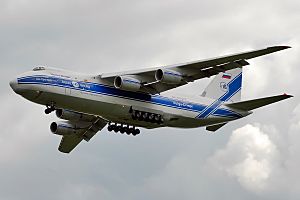 |
|
| An Antonov An-124 Ruslan preparing to land | |
| Role | Heavy transport aircraft |
| National origin | Soviet Union |
| Design group | Antonov |
| Built by | Antonov Serial Production Plant Aviastar-SP |
| First flight | 24 December 1982 |
| Introduction | 1986 |
| Status | In service |
| Primary users | Russian Aerospace Forces Volga-Dnepr Airlines Antonov Airlines |
| Produced | 1982–2004 |
| Number built | 55 |
| Unit cost | US$70–100 million |
| Developed into | Antonov An-225 |
The Antonov An-124 Ruslan (also known by its NATO reporting name: Condor) is a giant, four-engine airplane. It was designed in the 1980s in Ukraine, which was then part of the Soviet Union. The An-124 is one of the biggest cargo planes ever built. Only the Antonov An-225 Mriya (which was even larger and based on the An-124, but sadly destroyed) and the Boeing 747-8 are heavier. It's still the largest military transport plane flying today.
Design work for this huge aircraft began in 1971. It was created because the Soviet Air Forces needed a way to carry very heavy loads. Two main factories built the An-124: one in Ulyanovsk, Russia, and another in Kyiv, Ukraine. The first An-124 was built in 1979. It made its first flight on December 24, 1982. The world first saw the An-124 at the 1985 Paris Air Show.
After the Soviet Union broke up, the An-124 started being used for commercial flights. It received special permission for civil use in 1992. Many companies bought these planes, often using older military ones or unfinished aircraft. By 2013, 26 An-124s were flying for businesses. There were plans to build more, but these plans were stopped due to political challenges between Russia and Ukraine. Today, the only factory still able to produce parts for the An-124 is in Ulyanovsk, Russia.
Contents
Building the Giant: How the An-124 Was Developed
Why a New Giant Plane Was Needed
In the 1970s, the Soviet Air Forces needed bigger planes to carry heavy equipment. Their largest planes at the time, the Antonov An-22 turboprops, were not big enough for all their needs. Soviet leaders wanted planes that could carry much more weight. This would mean fewer trips to move the same amount of cargo.
Designing the An-124 Ruslan
Design work for this huge project started in 1971 at the Antonov Design Bureau. The main designer for the An-124 was Viktor Tolmachev. During its development, it was called Izdeliye 400 (meaning Product #400). The An-124 looked a lot like the American Lockheed C-5 Galaxy, another large transport plane. However, the An-124 had some improvements. It used more carbon-fibre composites (about 5% of its weight) and more titanium. Most of the plane is made from aluminium alloys. Unlike the C-5, the An-124's cargo area is not fully pressurized, and it cannot refuel in the air.
Building the First An-124s
In 1973, factories began to be built to produce the new plane. Two main assembly lines were set up: one in Ulyanovsk, Russia, and another in Kyiv, Ukraine. More than 100 factories across Eastern Europe provided parts for the An-124. The first plane started being built in 1979.
The An-124 made its first flight on December 24, 1982. Three years later, it was shown to the world at the 1985 Paris Air Show. After the Soviet Union ended, Antonov worked to get the An-124 approved for civilian use. This approval came on December 30, 1992.
Updates and Challenges for the An-124
Throughout the 1990s and early 2000s, many An-124s were sold to commercial companies. Often, these were old military planes that Antonov fixed up, or unfinished planes that were completed. In the early 2000s, the cargo company Volga-Dnepr upgraded its An-124 planes. These upgrades included new engines to make them quieter, stronger structures, and better electronics. These changes allowed the plane to be flown by a smaller crew.
In 2008, Russia and Ukraine talked about starting to build new An-124s again. A new version, the An-124-150, was announced. It could carry even more weight, up to 150 tonnes. However, these plans were put on hold in 2014 due to political challenges between Russia and Ukraine.
In 2017, some An-124s were upgraded in Russia. As relations between Russia and Ukraine became difficult, Antonov started looking for new suppliers for parts. In 2018, the American company GE Aviation looked into putting their CF6 engines on the An-124. This would likely make the plane fly farther. In 2019, Antonov announced plans to restart An-124 production without Russia's help.
Future Plans: Russia's Slon Design
At the MAKS Air Show in 2017, a Russian design center called TsAGI announced a new plane called the An-124-102 Slon (Elephant). This plane is meant to replace the An-124-100. The Slon would be built in Ulyanovsk, Russia. It is designed to carry 150 tonnes over 3,800 nmi (7,037 km) or 180 tonnes over 2,650 nmi (4,908 km). The Russian military wants it to carry five light tanks, 100 crew, and 300 soldiers over 4,100 nmi (7,593 km).
The planned Slon would be much larger than the An-124. It would have a new wing made of composite materials and new, more powerful Russian engines. Two different fuselage (main body) widths are planned: one for cargo companies and a wider one for the Russian military to carry vehicles side-by-side.
How the An-124 Ruslan Is Designed
The Antonov An-124 Ruslan is a very large, four-engine jet plane used for carrying heavy cargo. It looks similar to the American Lockheed C-5 Galaxy. Both planes have a special design that allows a cargo door at the front and back. The An-124 has a slightly shorter body but a wider wingspan than the C-5. It can also carry 17 percent more weight.
The An-124 uses a fly-by-wire control system. This means that computers help the pilots control the plane. It also has backup mechanical controls in case the computer system has a problem.
A single An-124 can carry up to 150 tonnes (about 330,000 pounds) of cargo inside. It can also carry 88 passengers in an upper deck behind the wings. The cockpit and crew area are also on this upper deck. There are foldable ladders to move between the upper and lower decks. The cargo area of the An-124 is about 36 meters (118 feet) long, 6.4 meters (21 feet) wide, and 4.4 meters (14.4 feet) high. This is about 20% larger than the cargo area of the C-5 Galaxy.
The main cargo area is not fully pressurized. This means that people or paratroopers carried there would need oxygen masks and warm clothes. However, the upper deck where the crew and passengers sit is fully pressurized. The floor of the cargo deck is made entirely of titanium, which is a very strong and expensive metal. This strong floor allows it to carry almost any heavy vehicle, including multiple main battle tanks.
The An-124 is powered by four Lotarev D-18 turbofan engines. Each engine is very powerful, providing up to 250,000 kN of thrust. To help the plane land in a shorter distance, the engines have thrust reversers. Pilots say the An-124 is surprisingly easy to fly for its huge size. It also has two smaller engines called auxiliary power units (APUs). These APUs provide power when the main engines are off.
The landing gear of the An-124 has 24 wheels with a special suspension system. This system allows the plane to land on rough ground. It can also "kneel" by lowering its nose. This makes it easier to load and unload cargo through the front door. Other features that help with loading include a crane inside the cargo deck that can lift up to 30 tonnes. Items up to 120 tonnes can be pulled onto the plane using a winch. The plane also has two radar units: one for navigation and another for checking the weather.
An-124 in Action: Operational History
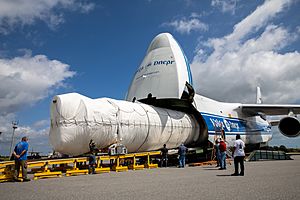
In the 2000s, Germany led a plan for NATO to rent An-124s. This was a temporary solution until the Airbus A400M Atlas planes were ready. Under the NATO SALIS program, six An-124-100 transport planes are rented. These planes are used by 18 countries to transport cargo. Two An-124s are always based at Leipzig/Halle Airport in Germany. If needed, two more can be provided in six days, and another two in nine days. These planes have been very helpful for NATO operations, especially in Iraq and Afghanistan.
The United Launch Alliance (ULA) uses the An-124 to move parts of its Atlas V rockets. These parts are flown from factories in Alabama and Colorado to launch sites in Florida and California. It takes two flights to move each rocket. The An-124 is also used by other companies to transport satellites and rocket parts.
By 2013, the An-124 had visited 768 airports in over 100 countries!
By late 2020, three companies were still flying An-124s for commercial purposes: Antonov Airlines (7 planes), Volga-Dnepr Airlines (12 planes), and Maximus Air Cargo (1 plane). In November 2020, Volga-Dnepr temporarily stopped flying its An-124s to check their engines after one had a problem during takeoff in Russia. By the end of December 2020, the first Volga-Dnepr An-124 was back in service.
Important Flights and Events

- In May 1987, an An-124 set a world record by flying 20,151 km (12,521 miles) without refueling. The flight lasted 25 hours and 30 minutes.
- In July 1985, an An-124 carried 171,219 kg (377,473 lb) of cargo to an altitude of 2,000 m (6,560 ft).
- In June 1994, an An-124 flew a diesel-electric locomotive from Canada to Ireland for testing.
- An An-124 was used to transport the Obelisk of Axum from Rome back to Ethiopia in April 2005.
- In July 2010, an An-124 helped clean up the Deepwater Horizon oil spill by transporting special boats from France to the US.
- In April 2011, an An-124 airlifted a large Putzmeister concrete pump from Germany to Japan. This pump helped cool reactors damaged in the Fukushima nuclear accident.
- During the COVID-19 pandemic, several An-124s carried masks and other medical supplies from China to other countries.
- On February 24, 2022, an An-124 was destroyed by Russian artillery during the Battle of Antonov Airport in Kyiv.
- On March 3, 2023, an An-124 delivered 101 tons of humanitarian aid for earthquake victims in Turkey and Syria.
- On June 9, 2023, an An-124 was taken by Canadian authorities at Toronto Pearson Airport. It had been stuck there after Canada closed its airspace to Russian planes.
Different Versions of the An-124
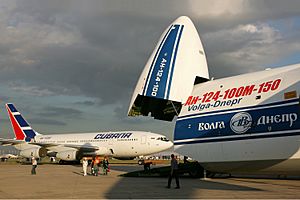
- An-124 Ruslan: The original heavy transport aircraft.
- An-124-100: A version for commercial transport.
- An-124-100M-150: An upgraded version that can carry 150 tonnes of cargo. It has stronger engines.
- An-124-102 Slon: A new design by TsAGI with modern flight controls.
- An-124-200: A proposed version with General Electric CF6-80C2 engines.
- An-124-210: A proposed version with Rolls-Royce RB211-524H-T engines and different electronics.
- An-124-300: A version ordered by the Russian Aerospace Forces.
Who Operates the An-124?
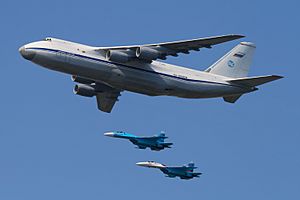
Military Users
 Russia Russian Aerospace Forces: They have 12 An-124s in service and 14 in reserve. Many have been modernized.
Russia Russian Aerospace Forces: They have 12 An-124s in service and 14 in reserve. Many have been modernized.
Past Military Users
 Soviet Union Soviet Air Force: Their planes were given to Russia and Ukraine after the Soviet Union ended.
Soviet Union Soviet Air Force: Their planes were given to Russia and Ukraine after the Soviet Union ended.
Civilian Users
As of late 2020, 20 An-124s were flying for commercial companies.
 United Arab Emirates Maximus Air Cargo: They have 1 plane.
United Arab Emirates Maximus Air Cargo: They have 1 plane.
Past Civilian Users
 Libya Libyan Arab Air Cargo: Had 2 planes, but one was seized and one was destroyed.
Libya Libyan Arab Air Cargo: Had 2 planes, but one was seized and one was destroyed. Russia Aeroflot Russian International Airlines: No longer use them.
Russia Aeroflot Russian International Airlines: No longer use them. Russia Polet Airlines: Stopped flying in 2014.
Russia Polet Airlines: Stopped flying in 2014. United Kingdom Air Foyle Heavylift: This partnership ended in 2006.
United Kingdom Air Foyle Heavylift: This partnership ended in 2006.
An-124 Accidents
Since 2019, there have been five major accidents involving the An-124, resulting in 97 deaths.
- On October 13, 1992, an An-124 crashed near Kyiv, Ukraine, during testing. Eight of the nine crew members died.
- On November 15, 1993, an An-124 crashed into a mountain in Iran. 17 people died.
- On October 8, 1996, an An-124 crashed in Italy while trying to land in bad weather. Four people died.
- On December 6, 1997, an An-124 crashed into a neighborhood after taking off in Irkutsk, Russia. All 23 people on board and 49 people on the ground were killed.
- On November 13, 2020, an An-124 had an engine problem after takeoff from Novosibirsk, Russia. The plane landed but went off the runway, and its nose landing gear broke. The airline temporarily stopped flying its An-124s for checks.
An-124 Facts and Figures (An-124-100M)
- Crew: Eight people (pilot, copilot, navigator, chief flight engineer, electrical flight engineer, radio operator, two loadmasters).
- Capacity: Can carry 88 passengers in the upper back part of the plane, or up to 150,000 kg (330,000 lb) of cargo.
- Length: 69.1 meters (226 feet 8 inches).
- Wingspan: 73.3 meters (240 feet 6 inches).
- Height: 21.08 meters (69 feet 2 inches).
- Empty weight: 181,000 kg (399,000 lb).
- Maximum takeoff weight: 402,000 kg (886,200 lb).
- Engines: Four Progress D-18T turbofan engines.
- Cruise speed: 800–850 km/h (497–528 mph) at high altitudes.
- Range: 3,700 km (2,300 miles) with maximum cargo.
- Ferry range: 14,000 km (8,700 miles) with maximum fuel and minimum cargo.
- Maximum altitude: 12,000 meters (39,400 feet).
- Take-off distance: 3,000 meters (9,800 feet) when fully loaded.
- Landing distance: 900 meters (3,000 feet) when fully loaded.
See also
 In Spanish: Antonov An-124 para niños
In Spanish: Antonov An-124 para niños
- Aircraft related to this one
- Similar aircraft
- Airbus Beluga
- Boeing 747-400F
- Boeing 747-8F
- Boeing C-17 Globemaster III
- Lockheed C-5 Galaxy
- Ilyushin PAK VTA





